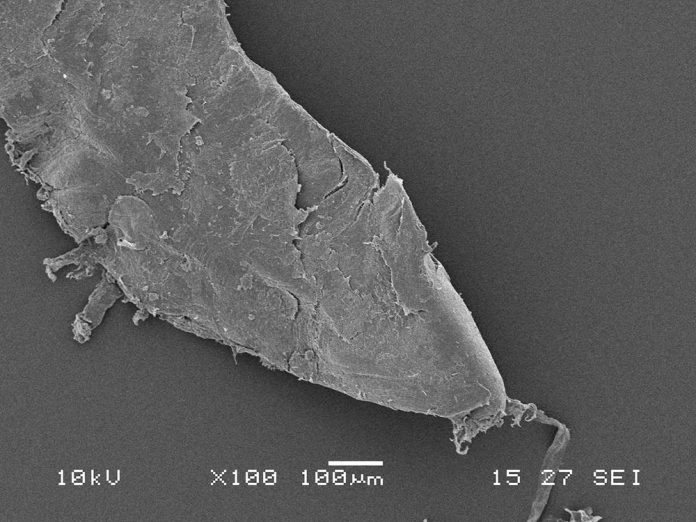Understanding the impact of microplastics on the environment and on human and animal health is a crucial challenge for the next century. However, before the true impact of microplastics can be calculated, first we must refine our methods of detecting and categorising microscopic and particle-sized plastics.
Bert Swart, Franciszek Bydalek, Professor John Chew and Dr Jannis Wenk from the University of Bath’s Water Innovation and Research Centre (WIRC) explain how they are approaching the issue and how the water industry can help.
The ecological impact of plastic on the environment has been well-reported: it causes both great ecological damage and is an eyesore. Larger plastic parts from consumer products and packaging can be found almost everywhere, for example in the oceans, at the most remote beaches, in rivers and on roadsides. But perhaps even more concerning that the plastics we can see are those we cannot.
Microplastics are defined as plastic particles smaller than 5mm but they can often be microscopically small. Particles present in the environment originate from many sources, such as weathered or worn larger plastics and tyre wear from cars – but they can also be deposited through municipal wastewater. For example, ocean sediments sampled at a depth of several thousand metres have been found to contain almost 2 million microplastic particles per square metre.
The minute size of microplastics makes studying their environmental effects extremely difficult. Like larger plastic, microplastic is persistent in the environment and it presents significant risks. Microplastics can be ingested by small organisms such as krill, shellfish and juvenile fish, as well as larger filter feeders including whale sharks. In these smaller animals, microplastics may disrupt the digestive system with deadly consequences – as many small animals comprising the base of marine, coastal and river food webs and serve as food source for commercially important fish. Therefore, microplastic pollution may eventually affect fish populations, and human food security.
Similarly harmful is the way in which plastic can attract pathogens and toxic chemicals known as endocrine disrupting compounds. These chemicals usually exist at very low concentration in water, but they can adhere to or inside plastic particles and become released once ingested. Via a process known as bioaccumulation these toxic chemical may further concentrate through the food web and slowly poison fish and humans that eat that fish.
Beyond a better understanding of the environmental effects of microplastics it is critical to minimise the release of microplastics into natural waters. Wastewater effluent can be a significant source of microplastics, specifically synthetic fibres from clothes and additives of cosmetics such as body scrubs and peeling products.
Most wastewater treatment plants are not designed to efficiently remove microplastics, while detailed inventories of microplastic fluxes through wastewater treatment plants are rarely available. Data collection is often hindered by the absence of fast and reliable microplastic detection methods. Therefore, in our research groups we work on better and more rapid microplastics detection methods to differentiate and quantify microplastics, and assess the severity of the issue in UK municipal wastewaters.
Detection and identification of microplastics in wastewater presents various challenges. While particles larger than 0.5 mm are relatively straightforward to extract, smaller particles remain often undetected or may be destroyed during sample processing.
A huge variety of approaches and equipment can be used to detect and quantify microplastics – manual and semi-automated microscopic methods can be used to count particles, as well as materials characterisation via spectroscopy or spectrometry.
The challenge is to have fast, less laborious but at the same time accurate, reliable and repeatable detection and characterisation methods for a wide ranging size distribution.
An automated computer-based high speed camera method for microplastics quantification is currently in development within WIRC at Bath.
A successful detection followed by identification of plastic type and shape requires first the removal of any organic and inorganic impurities such as biofilms, fats, proteins and sand. Cleaning methods include the use of strong surfactants and most importantly oxidation processes that remove non-plastic compounds selectively. Nevertheless, many detection methods suffer from 50% losses for particles smaller than 0.05 mm, which leads to a significant underestimation of the total amount of plastic particles.
Following sample preparation, both physical and chemical plastics characterization takes place. There are a variety of different methods available including microscopic techniques for shape analysis microscopic and advanced instrumentation for material analysis. Latter methods are also useful to look at effects of weathering and identify the source of microplastic particles.
In addition to using state-of the art microplastics detection and characterisation methods we have developed a setup that allows the observation and tracking of particles in solution by utilising automated image analysis. The solution is viewed through a transparent viewing slit using a high-resolution camera.
Carrying out subsequent electronic image analysis allows easy identification of particle size within the micron range. The system is also being further developed and trained to distinguish different plastic types and non-plastic particles.
Parallel to the development of new detection methods, we are investigating the fate of microplastics in wastewater treatment plants and constructed wetlands.
For example, our data indicate that constructed wetlands have the potential to hold back inflowing microplastics. However, we also observed the release of weathered and partially fragmented microplastics from constructed wetlands.
Given the global scale of plastics pollution including microplastics, it seems inevitable that wastewater treatment plants may need to become better at cutting down the release of microplastics into the environment.
Progress is already being made as some treatment setups including membrane bioreactor discs and rapid sand filtration or dissolved air flotation are currently reported to be capable of reaching over 95% removal of microplastics. Financial constraints might specifically encourage looking into the potential of existing facilities first, before making large investments. Our work helps to understand the fate of microplastics and can point towards ways for better removal of microplastic from wastewater streams.




